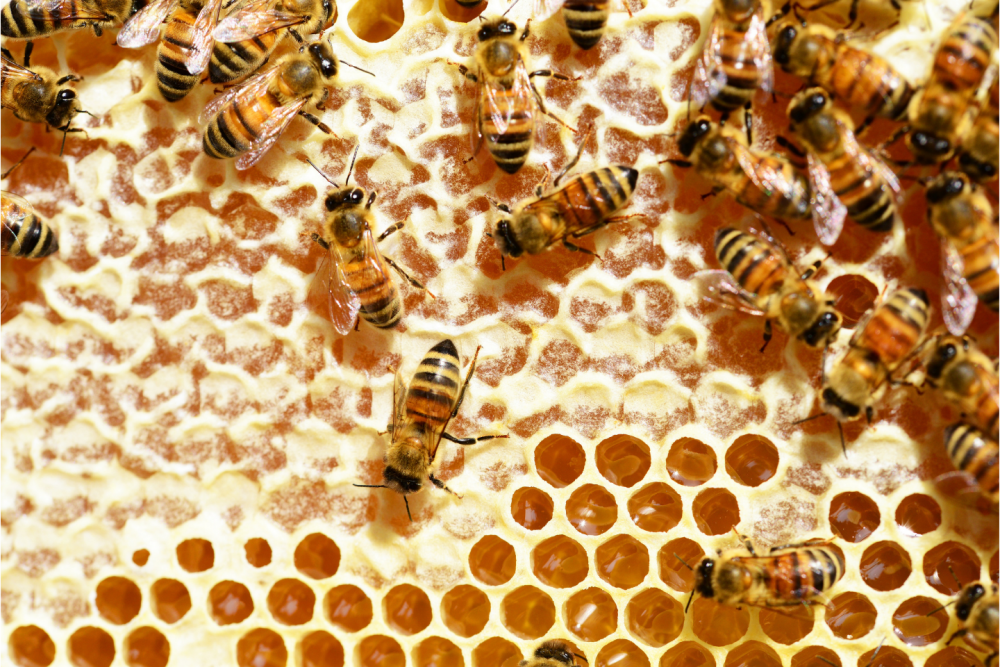
Pollinators in the Biology Classroom is a standards-aligned, 5-E life science unit that teaches about aerobic and anaerobic respiration, genetics, biotechnology, and food safety in the context of honey bees.
Overview
In this unit, students will learn about genetic factors that influence food resource preference. A gel electrophoresis simulation introduces students to a biotechnology tool that allows scientists to investigate how genetics affect honey bee behavior. A cellular respiration lab will allow students to examine the chemical changes that can ferment honey and how these changes affect food preservation and food safety both in the hive and on our store shelves. Lastly, students will extend their learning to a larger context by exploring the honey bee’s role in socioscientific issues including maintaining a safe food supply and overcoming the challenge of food preservation in areas lacking consistent electricity for refrigeration.
Lesson 1 | Good Taste: Forager Food Preference
- Students will examine data about the foraging behavior of bees. They will then predict if the bee’s behavior is related to its ability to detect minimal concentrations of sugar. Students will determine which type of foraging bee would be best for pollination or honey production. Students will learn about the process of gel electrophoresis as a genetic tool. They will then analyze DNA to identify better pollen-collecting bees.
Lesson 2 | Fermentation of Honey
- This lesson will teach students about the processes of cellular respiration and fermentation for the transformation of glucose into usable energy (ATP) for living organisms. In some cases, the competition between living organisms for carbohydrates leads to undesired products and concern for foodborne contaminants.
Lesson 3 | Preservation Power of Honey
- Students will learn how honey is an antibacterial agent. Honey may be used as a preservative of milk in areas without access to electricity or refrigeration. This preservation relies on elements found specifically in honey and cannot be replicated with other sources of sugar.
Lesson 4 | Honey as a Biomolecule
- This lesson teaches about different types of carbohydrates, the role of enzymes in breaking down complex sugars into simple sugars, and how different sugars impact our perception of sweetness and may impact human health.
Lesson 5 | Imported Food Safety
- Students will examine where their food comes from, federal agencies involved in protecting our food supply, how imported foods such as honey present a safety challenge, and what measures are being taken to meet these challenges.
Curriculum Connections
Next Generation Science Standards
- HS-LS1-7 Use a model to illustrate that cellular respiration is a chemical process whereby the bonds of food molecules and oxygen molecules are broken and the bonds in new compounds are formed resulting in a net transfer of energy
- HS-LS2-2 Use mathematical representations to support and revise explanations based on evidence about factors affecting biodiversity and populations in ecosystems of different scales.
- HS-LS3-1 Ask questions to clarify relationships about the role of DNA and chromosomes in coding the instructions for characteristic traits passed from parents to offspring.
- HS-ETS1-1 Analyze a major global challenge to specify qualitative and quantitative criteria and constraints for solutions that account for societal needs and wants.
- Student Resources (Word Doc) (898.96 KB)
- Student Resources (PDF) (723.44 KB)
- Teacher Resources (Word Doc) (1.7 MB)
- Teacher Resources (PDF) (1.1 MB)
- Fermentation of Honey - Lesson 2 Presentation (PPT) (638.43 KB)
- Preservation Power of Honey - Lesson 3 Presentation (PPT) (4.43 MB)